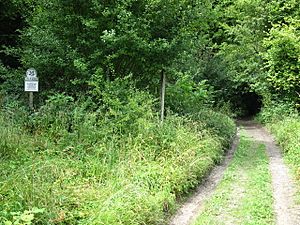Selborne Common facts for kids
| Site of Special Scientific Interest | |

Entrance to Selborne Common
|
|
| Area of Search | Hampshire |
|---|---|
| Interest | Biological |
| Area | 99.6 hectares (246 acres) |
| Notification | 1986 |
| Location map | Magic Map |
Selborne Common is a special natural area in Hampshire, England. It covers about 99.6 hectares (246 acres) and is protected because of its amazing wildlife and plants. This area is managed by the National Trust, a charity that looks after important places. Selborne Common is also part of a larger protected area called the East Hampshire Hangers Special Area of Conservation.
Contents
What Does Selborne Common Look Like?
Selborne Common sits on top of Selborne Hill, which is part of the Hampshire Downs. The highest point is about 680 feet (207 meters) above sea level. Some parts of the hill slope gently, while others are very steep.
Steep Slopes and Valleys
The steepest part is called "Selborne Hanger," which overlooks the village. It's super steep, almost like a wall! Next to it is Coneycroft Hill, which is also very steep. In between these two hills, there's a deep valley or "dell."
What is the Ground Made Of?
The soil at Selborne Common is mostly clay mixed with flint stones. This sits on top of chalk, which is the same rock that makes up the famous South Downs. Water flows underground here. It eventually joins two streams, the Oakhanger Stream and the Caker Stream, which then flow into the River Wey.
Plants and Trees of Selborne Common
Selborne Common is famous for its beautiful and rare plants. The very steep slopes are covered in old beech trees. In this part of England, a steep beechwood is often called a "hanger."
Forests and Grasslands
The flatter top of the hill has more beech trees, mixed with other trees like English oak, ash, and hawthorn. Some areas are a bit wild and scrubby. There's also a small open grassland with gorse bushes and bracken ferns. Recently, more areas of chalk grassland have been created to help different plants grow.
Amazing Wildflowers
You can find many wildflowers here, including yellow archangel, wood spurge, and wood anemone. A plant called Spurge-laurel is also found scattered around. Even more interesting plants like stinking hellebore, green hellebore, and several types of rare bird's nest orchid and helleborines grow here. One type of helleborine, E. x schulzei, was first found in Britain right here in 1931!
Animals of Selborne Common
Selborne Common is home to many different animals, from tiny snails to large deer.
Butterflies and Insects
Many rare snails and insects have been found here. If you visit, you might spot beautiful butterflies like the Duke of Burgundy, silver-washed fritillary, and the stunning purple emperor.
Birds in the Woodland
The woods are full of birds typical of southern England. You might see a sparrowhawk flying overhead, or hear a tawny owl at night. Other common birds include stock dove, European green woodpecker, great spotted woodpecker, and various small songbirds like garden warbler, blackcap, and chiffchaff. Look out for the spotted flycatcher, marsh tit, nuthatch, treecreeper, and jay.
Rare Bird Visitors
Buzzards are often seen hunting above the trees. Sometimes, you might even spot a hobby, woodcock, common firecrest, or brambling. Selborne Common is also a great place to find the wood warbler.
Mammals Living Here
The main mammals you might see are Roe deer and the tiny, sleepy dormouse.
History and How the Common is Cared For
People have used Selborne Common for a very long time. There's evidence of old field systems from prehistoric times or the Roman period. These fields might have been used again in the Middle Ages. The Common has not been ploughed since then.
Old Boundaries and Fences
On the western side, there are old earthworks that might be from the 1200s, when Newton Park was created. An earth bank running across the Common, built around 1750, probably helped protect the coppice woodland from grazing animals.
Traditional Uses of the Land
In the 1700s, the local lord of the manor cut down beech trees on the Common. But local people also had "common rights." This meant they could graze their cattle and sheep and collect firewood. These activities continued until the 1950s.
Modern Management and Conservation
In medieval times, Selborne Priory owned the land. Later, it was given to Magdalen College, Oxford, which then donated it to the National Trust in 1932. Today, cattle have been brought back to the Common. This helps to bring back the old, flower-rich wood-pasture habitat that was once common in England but has almost disappeared. There is also a dew pond called Wood Pond near the western edge.
Gilbert White's Connection
Selborne Common is famous worldwide because of its link to Gilbert White. He was a naturalist who lived in the 1700s and wrote a very famous book about nature in Selborne.
How to Visit Selborne Common
Everyone can visit Selborne Common for free. The best way to get there is from Selborne village. You can use the steep "Zig-Zag" or "Bostal" paths. There's a car park behind the Selborne Arms pub. A flatter path also leads to the Common from Newton Valence. Other footpaths connect from the south-east and north-west. Be aware that some paths can get very muddy, especially after rain or in winter.
Selborne Common is also part of a walking trail called the Hangers Way.
Images for kids


